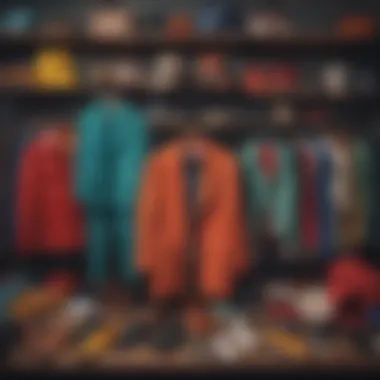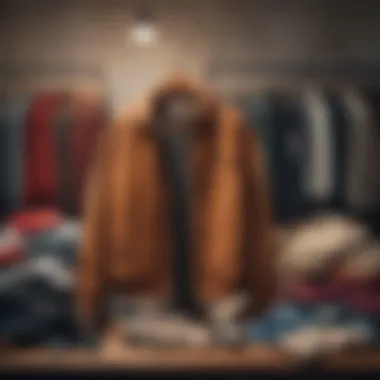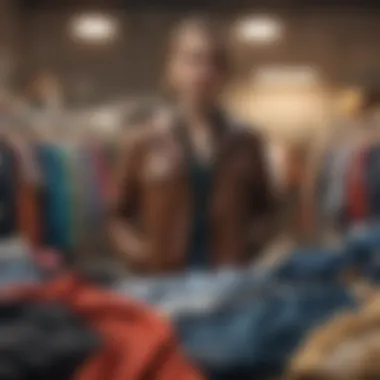Vinted and the Second-Hand Clothing Market: A Deep Dive


Intro
In the contemporary economic landscape, second-hand clothing has emerged as a significant segment. Vinted has capitalized on this trend, providing a platform for users to buy and sell pre-owned fashion. This article aims to break down the dynamics and implications of engaging in second-hand commerce through Vinted.
Understanding this marketplace goes beyond just transactions; it encompasses consumer behavior, economic benefits, and the broader societal implications of choosing sustainable fashion.
Vinted: A Platform for Second-Hand Fashion
Vinted has grown from a niche marketplace to a dominant player in the second-hand clothing market. It enables users not only to buy second-hand items but also to sell their own clothing. Users receive direct access to a vast audience wishing to support sustainable fashion, thus shaping a vibrant community.
Through a user-friendly interface, Vinted has disrupted traditional retail. Both individual sellers and budget-conscious buyers benefit significantly from this platform. As consumer interest shifts, new trends in how we regard clothing circulation are emerging, reflecting a growing awareness toward sustainability and frugal shopping.
Economic Implications of Second-Hand Shopping
A substantial aspect that warrants attention is the economic impact of platforms like Vinted. By buying and selling used items, consumers directly influence supply and demand. They partake in a cycle that supports local economies and encourages repurposing of clothing.
There are concrete economic benefits when engaging in second-hand purchases through Vinted. Key effects include:
- Reduction of ecological impact through recycling clothing.
- Affordability for consumers seeking lower prices.
- Financial gains for sellers looking to clear their wardrobes.
While the advantages are clear, the challenges such as marking reliable transactions need discussion as they affect trust in the marketplace.
The Societal Impact
Consumer behavior is indeed shifting toward more eco-friendly options. By promoting the adoption of second-hand clothing, Vinted not only changes individual purchasing habits but also encourages a broader shift in societal attitudes towards consumption. The alignment of maintaining fashion while reducing waste fosters notion of responsible buying that is relevant today.
Overall, this detailed insight into Vinted not only illustrates its operational mechanics but also addresses consumer trends that will likely define the future of the second-hand clothing market. Through clarity and persistancy, individuals engage actively in sustainable fashion, contributing positively to the global narrative of reduced consumption.
Intro to Vinted
The exploration of Vinted serves as a vital entry point to understanding the second-hand clothing market in today's consumer landscape. As an online platform dedicated to reselling clothing, Vinted not only democratizes fashion but also aligns with shifting societal attitudes towards sustainability and conscious consumption. Through this lens, the importance of Vinted unfolds, where it supports both buyers and sellers in navigating an economy that highly favors accessibility and environmental awareness.
Overview of the Platform
Vinted is an online marketplace specifically designed for buying, selling, and exchanging second-hand clothes and accessories. Founded in 2008 in Lithuania, it has since grown to have millions of users across various countries. The platform provides a straightforward way for individuals to list items they no longer wear and seek out affordable fashion finds from others. By fostering a community, it facilitates interactions between those who wish to declutter their wardrobes and others who desire new items without the retail markup. Notably, Vinted eliminates the traditional retail model, changing the way users interact with fashion and shopping.
The app is user-friendly, allowing users to browse through categories based on clothing type, size, and style preferences. By utilizing a rating system, potential buyers can assess seller reliability, adding a trust factor which is critical in any marketplace.
Vinted's Business Model
Vinted operates on a unique business model that sets it apart from many other e-commerce platforms. Unlike traditional retail companies that source or manufacture their own inventory, Vinted relies on its users to provide the items for sale, thus reducing overhead costs.
The key features of Vinted's business model include:
- Zero Commission for Sellers: Vinted allows users to sell their items without charging commissions, this encourages more individuals to use the platform.
- Verification System: To enhance security, Vinted has implemented a verification system for both buyers and sellers, fostering a safer marketplace.
- Extensive User Base: A large and active user community improves engagement, encourages trust, and enhances the overall marketplace.
These components synergistically work to create a seamless marketplace that capitalizes on the growing trend of second-hand shopping while remaining approachable and less intimidating for all users.
The Concept of Second-Hand Clothing
Second-hand clothing holds a significant place in the modern fashion landscape, offering various benefits not only to consumers but also to the environment. Understanding this concept helps to grasp its evolving industry dynamics, especially regarding platforms like Vinted.
Defining Second-Hand Clothing
Second-hand clothing refers to garments that have been previously owned and worn by someone else. These can range from casually worn pieces to designer items, and even vintage finds. This type of clothing often becomes available through several avenues such as thrift stores, consignment shops, donation programs, and more contemporary platforms like Vinted.
Second-hand clothing encourages a unique form of consumer behavior, where buyers focus on value, sustainability, and the uniqueness of pre-loved items. This choice influences trends, promoting a shift from fast fashion towards more thoughtful consumption.
Historical Context and Rise in Popularity
The concept of second-hand clothing has deep historical roots. For centuries, wearing second-hand garments was not only common but often seen as a necessity, especially during economic downturns. However, in recent decades, societal perceptions have shifted.


Several factors coupled together, leading to a resurgence in popularity for second-hand clothing. The rise in awareness about sustainability and the negative impacts of fast fashion is a significant driver. Social movements encourage sustainable practices, making consumers aware of their purchasing choices.
Furthermore, nostalgia in fashion has led to a renewed interest in vintage clothing. Young consumers actively seek unique pieces that differ from mass-produced items.
Another contributing factor is the global digital presence of platforms. Websites like Vinted facilitate easy trading of second-hand clothing, breaking barriers and connecting buyers and sellers effectively. Platforms allow for creativity and individuality in style while providing a community for shared sustainable values.
Overall, the surge in second-hand clothing reflects a broader societal shift toward sustainable practices and personal expression in fashion.
Economic Implications of Second-Hand Fashion
The second-hand clothing market has evolved into a significant economic force. Understanding its economic implications provides valuable insights into how this market influences both consumers and the broader fashion industry. Second-hand fashion is not just about finding affordable items; it also has various( significants) impacts on sustainability and economic practices. This section examines two key aspects of the second-hand economy: the cost savings for consumers and the impact on the fashion industry.
Cost Savings for Consumers
Cost savings form a core reason why individuals gravitate toward second-hand clothing platforms like Vinted. People seek ways to stretch their budgets while still acquiring quality items. With the soaring prices of retail clothing, buying second-hand significantly reduces the financial burden on consumers.
Purchasing pre-loved items allows buyers to access brands and styles that might otherwise be unaffordable. Vinted enables users to purchase items at a fraction of their original price, contributing to the appeal of the second-hand market. Also, consumers may purchase more while escaping the financial health that comes with fast fashion.
Conversely, the act of selling unused clothing aids in reclaiming some of the initial expenditure. Sellers can thereby rejuvenate their financial cushion by capitalizing on items they no longer use.
Several studies confirm consumer tendencies here:
- Affordability: A lower price range is typical.
- Diverse Choices: Unique items not accessible in retail stores.
- Sustainable Spending: Saves money while practicing environmental consciousness.
Impact on the Fashion Industry
The rise of second-hand clothing represents a paradigm shift within the traditionally linear fashion industry. The accumulation of fashion habits and consumer preferences reflects changing priorities focused on sustainability. Companies must respond to consumer demand for responsible production practices, or else risk losing business.
Surprisingly, the second-hand trend pushes some established retailers to consider “second-chance” collections, limited edition releases related to vintage trends, and sustainable partnerships. They aim to appeal to cost-conscious buyers while addressing sustainability concerns alerting young consumers.
Furthermore, this space promotes innovation with digital platforms. Online marketplaces elevating resale become a focal point for virtually connecting buyers and sellers. Those marketplaces significantly expand choices and market accessibility, giving rise to diverse economic activity.
The expansion of second-hand fashion reflects not just consumer behavior but also signals urgent change in an often monopolized fashion sector.
Ultimately, the conversation about economic implications places the second-hand clothing market at an intersection rich with challenges and opportunities. The market continues to reshape but assures sustained relevance across all stakeholders involved.
Environmental Considerations
The environmental implications of second-hand clothing extend beyond aesthetic choices; they hold significant importance in fostering sustainable practices. As concerns about pollution and the depletion of natural resources grow, engaging within the second-hand market is seen as a proactive measure towards mitigating environmental damage. This section investigates the key components that underline the relevance of sustainability and waste reduction in the second-hand clothing sector.
Sustainability in Fashion
Sustainability has emerged as a crucial topic in fashion, challenging the traditional model of fast fashion. The quest for environmentally friendly practices exposes the catastrophic ecological effects of overconsumption. Sustainable fashion emphasizes quality over quantity. It seeks to extend the lifecycle of clothing rather than promote depreciation after a single use. By choosing second-hand garments, consumers contribute to lowering demand for new textile production, which is notorious for its substantial water consumption and chemical pollution.
Renewed interest in nature-positive clothes has reshaped the image of thrifting. For consumers, second-hand clothing represents not only uniqueness but also a conscious decision to prioritize planetary health. This method of shopping reduces macro-level textile industry impacts. As large-scale retailers come under scrutiny, platforms like Vinted advocate for life cycle consideration in fashion, becoming a vehicle for sustainable consumption.
Waste Reduction Through Second-Hand Shopping
The importance of waste reduction in the context of second-hand buying cannot be overstated. Roughly, 92 million tons of textile waste is generated globally each year. Most ends up in landfills or is incinerated, contributing dangerously to greenhouse gas emissions. When shoppers opt for sites like Vinted, they partake in a cycle that lessens the volume of textiles entering waste streams. This simple action duplicates clothing usage and repositions fibers back into the cycle.
- Reductions in landfill contributions highlight the tangible impact of this choice.
- The carbon footprint from disposing new, unused textiles is reduced.
- Shoppers can maintain style integrity while promoting practicality and consciousness regarding planetary resources.
Studies indicate that wearing clothes longer diminishes their carbon footprint significantly, contributing positively to climate mitigation efforts.
Consumer Behavior on Vinted
Understanding consumer behavior on Vinted is crucial for grasping the overall dynamics of the second-hand clothing market. This section sheds light on how buyers and sellers interact within this platform, emphasizing the motivations behind their choices and the impact of user behavior on Vinted's thriving ecosystem.
Demographics of Buyers and Sellers


The Vinted platform attracts a diverse range of users. Buyers and sellers span various age groups, income levels, and geographical locations. Notably, younger users dominate the buyer demographics. Studies show that people between the ages of 18-34 make up a sizable portion of the buyer base. These users are often eco-conscious and appreciate the benefits of sustainable practices in fashion. This demographic values affordability and the allure of vintage items.
Conversely, sellers tend to include a broader age spectrum. Older users, particularly those interested in decluttering their wardrobes, often choose to list items on Vinted. Sellers commonly see the platform not only as a way to make money but also as an opportunity to give their clothes a second life. Gender demographics also reveal significant insights; women are primary sellers, while both women and men frequently buy from the platform.
In summary, understanding demographics aids in evaluating purchasing behavior, setting trends, and guiding marketing strategies on Vinted.
User Experience and Satisfaction
The user experience on Vinted plays a pivotal role in shaping consumer satisfaction. Vinted’s interface is designed for ease of use, enabling quick navigation for both prospective buyers and sellers. Listing an item takes just a few steps, which promotes seller engagement. Features such as search filters, item categories, and seller ratings contribute to a smooth shopping experience.
User satisfaction hinges on aspects like feedback mechanisms, where both buyers and sellers can evaluate each other after transactions. Positive reviews create a virtuous cycle leading to increased trust in transactions. Additionally, effective communication tools allow users to ask questions regarding listed items, erasing hurdles that could obstruct successful sales.
However, challenges do exist. Issues of inaccurate item representation can arise, potentially dampening user satisfaction. Consequently, both buyers and sellers must ensure transparency about item conditions to nurture trust within this marketplace.
Vinted's user engagement is not just about buying and selling; it reflects the platform’s success in nurturing a community focused on sustainability.
By actively analyzing these behaviors, stakeholders can optimize engagement and function within the growing second-hand economy.
Navigating Vinted: A User Guide
The success of Vinted rests not just in its marketplace but also in how easy it is to navigate. Understanding this platform is crucial for both buyers and sellers who wish to maximize their experiences. This user guide unveils pertinent information about using Vinted effectively, ensuring that the benefits of second-hand shopping are accessible to all users.
Creating an Account
To begin using Vinted, users must first create an account. The registration process is relatively straightforward. Individuals can opt for using an email address or social media connections to join. Once authenticated, users should take the time to complete their profiles. A well-crafted profile can enhance trust among prospective buyers or sellers. Incorporating genuine profile pictures and relevant information can paint a better picture of one's credibility within the community.
Steps to Create an Account:
- Visit the Vinted website or download the mobile app.
- Click on the “Sign up” button.
- Choose a method of registration (email or social media).
- Fill in essential details such as name, location, and preferred shopping process.
- Verify the account through an email confirmation.
Listing Items for Sale
Once registered, users can start decluttering their wardrobes by listing items for sale. This part requires attention, given the competitive nature of online marketplaces. The quality of the listings greatly affects selling success. High-resolution images and detailed descriptions capture potential buyers' interests, leading to quicker sales and satisfactory user experiences.
Listing Best Practices:
- Take multiple clear photos from different angles of the item.
- Include detailed descriptions mentioning size, brand, condition, and cualquierthing specific about the item.
- Set a reasonable price after researching similar items to avoid overpricing or underselling.
By adhering to these guidelines, sellers are more likely to attract attention while minimizing the risk of unsold items.
Purchasing Items
Purchasing clothes on Vinted can be a thrilling experience, with countless options at one’s fingertips. Navigating the purchase process involves searching for desirable items and communicating with sellers. It's key for potential buyers to inquire about item conditions and shipping details before making payments.
Recommended Steps to Make a Purchase:
- Use the search function to find the desired item.
- Review photographs and descriptions carefully.
- Communicate with the seller for any clarifications.
- Ensure that payment methods are secure before confirming the order.
Following these protocols ensures a positive shopping experience. Being transparent during negotiations and checkout can help in building trust on the platform, potentially enhancing one’s rate of return customers or successful purchases in future encounters.
Remember: A clear line of communication with users facilitates everything from listing to purchasing, creating a cohesive community around sustainable fashion.
Challenges of Second-Hand Shopping
The growth of second-hand shopping is notable, but it accompanies unique challenges. Marx realized that all types of markets have inherent obstacles. second-hand shops are no exception. These are especially relevant for platforms like Vinted. Understanding these challenges is crucial for users to enhance their experience while buying or selling.
Quality Concerns


One of the most significant challenges for consumers is ensuring quality. Not all used items are in mint condition. Shifted seams, missing tags, or unsightly stains can reduce the appeal of a purchase. Moreover, trust in the descriptions provided by sellers holds immense weight. It is crucial for prospective buyers to verify claims before deciding.
Here are some key factors regarding quality concerns:
- Assessment of Condition: Item rating can help. Vinted has features allowing sellers to categorize items based on health. However, users still must rely on images and written details.
- Return Policies: Vinted's policies might not guarantee the return of unsatisfactory goods. Knowing this adds an essential layer of scrutiny before clicking ‘purchase.’
- Consumer Awareness: Knowledge about specific brands can make a difference. Familiarity with sizing or material can show what to anticipate.
By grasping these factors beforehand, users can minimize the risk associated with quality.
Scams and Fraud Prevention
Another pressing issue is the risk of scams. Online marketplaces present vulnerabilities both for buyers and sellers. Vinted aims to ensure safe transactions, yet skepticism is not unwarranted. Users must be proactive in safeguarding their transactions.
Consider the following aspects regarding scams and fraud:
- Payment Methods: Use Vinted’s secure payment methods exclusively. Setting aside personal choices like cash and opting for technological safety nets protect users.
- User Verification: Profiling can help establish trust. Check seller profiles thoroughly. Responses to past buyers and feedback can serve as forums of reassurance.
- Be Wary of Too-Good-To-Be-True Deals: Suspiciously low price may indicate fraud. Conduct market research for a fair price gauge.
In vigilance, by being aware of potential scams, users can better navigate the challenges.
Understanding and addressing these challenges leads to a far superior experience in second-hand shopping, especially in a dynamic marketplace like Vinted.
The Future of Second-Hand Clothing
The future of second-hand clothing represents a significant transformation within the fashion industry. As societal perceptions regarding sustainabilitychange, the second-hand market continues to evolve. This trajectory depicts not only a shift in consumer behavior but also anticipates broader economic implications.
Trends in Second-Hand Shopping
The trends in second-hand shopping reflect a changing mindset. More individuals are opting for pre-loved clothing—not just for economic reasons, but also for ethical motives. Some key trends include:
- Increased Awareness: Consumers today are more informed about environmental issues and the impact of fast fashion. This awareness leads to a preference for sustainable choices.
- Online Marketplaces: Platforms like Vinted, Depop, and Poshmark facilitate ease of use for buyers and sellers, making second-hand clothing highly accessible. Digital culture plays a big role here.
- Unique Finds: Many shoppers appreciate the one-of-a-kind pieces that second-hand options provide. Vintage or rare items often have a story and uniqueness not found in new offerings.
Ultimately, these trends denote a stable demand for second-hand apparel. They signify a shifting landscape where second-hand does not merely supplement retail—it is becoming vital.
Technology's Role in the Evolution
Technology increasingly shapes the future of second-hand shopping. Several aspects highlight this influence:
- User-Friendly Apps: Major platforms benefit from intuitive design, which enhances user experience. A smooth interface encourages expanded usage.
- Social Media Integration: Social media plays a role in trends, allowing sharing and discovery. This integration also enhances community connection among users.
- AI and Personalization: AI technology is making its way into predicting buying patterns and preferences. Personalization encourages customers to return regularly due to tailored suggestions.
In summary, the future aspect of second-hand clothing suggests a sustainable choice backed by changing buyer perceptions and technology advancements. This progress could shape broader market dynamics, influencing how products are valued and consumed.
The End
In summary, the significance of this conclusion within the context of the article brings together multiple aspects of how Vinted operates within the second-hand clothing market. It emphasizes the current relevance of second-hand fashion in modern society and touches on consumer behavior, economic factors, and environmental impact. Understanding the dynamics that Vinted brings to both sellers and buyers creates its own niche that reflects the shift towards more sustainable practices in fashion.
By synthesizing insights from various sections, we grasp that second-hand shopping is not merely a trend, but a fundamental reevaluation of consumer habits and values. Vinted exemplifies how digital marketplaces facilitate these changes, making the pursuit of affordability and sustainability more accessible to everyone.
"Transitioning to a second-hand mindset can reshape preconceived notions about consumption."
Furthermore, the growth of second-hand markets like Vinted requires broadening our understanding of fashion consumption. Here are some key takeaways:
- The efficiency of second-hand shopping caters to diverse demographics.
- Economic advantages span both buyers and sellers.
- Environmental benefits promote a sustainable lifestyle.
On another note, the challenges present within buying second-hand garments continue to be a topic of interest, requiring ongoing discussions on quality and safety protocols.
Ultimately, the exploration into Vinted and the second-hand clothing market highlights an adaptive response to consumers' evolving values. This readiness to rethink fashion consumption marks a distinct evolution in how society approaches purchases, ultimately guiding future trends and innovations in the sector.
Summary of Insights
The preceding content underscores key insights regarding Vinted's pioneering role in propagating second-hand fashion. Notably:
- Economic Implications: Vinted acts not just as a platform for exchanges but fosters an ecosystem that benefits various stakeholders: buyers save money, while sellers monetize pre-owned items.
- Consumer Behavior: Data shows increasing numbers of people are becoming target audience for second-hand purchasing, driven by a need for affordability and a growing awareness of sustainable practices.
- Environmental Considerations: The tradition of second-hand shopping significantly lessens waste and promotes a more responsible manufacturing cycle.
- Technological Impact: The interface and algorithms Vinted employs optimize user experiences, simplifying sales and purchases and minimizing perceived risks in this marketplace.
Final Thoughts on Vinted and Second-Hand Clothing
Reflecting upon this exploration, it is clear that Vinted serves a more substantial role than being merely an app. It represents a shift in cultural values towards sustainable fashion. Moreover, the way this platform is structured directly responds to economic behaviors, facilitating seamless transactions between like-minded individuals averse to disposable fashion.







